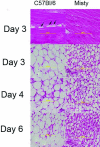Hypoxic adipocytes pattern early heterotopic bone formation
- PMID: 17255330
- PMCID: PMC1851874
- DOI: 10.2353/ajpath.2007.060692
Hypoxic adipocytes pattern early heterotopic bone formation
Abstract
The factors contributing to heterotopic ossification, the formation of bone in abnormal soft-tissue locations, are beginning to emerge, but little is known about microenvironmental conditions promoting this often devastating disease. Using a murine model in which endochondral bone formation is triggered in muscle by bone morphogenetic protein 2 (BMP2), we studied changes near the site of injection of BMP2-expressing cells. As early as 24 hours later, brown adipocytes began accumulating in the lesional area. These cells stained positively for pimonidazole and therefore generated hypoxic stress within the target tissue, a prerequisite for the differentiation of stem cells to chondrocytes and subsequent heterotopic bone formation. We propose that aberrant expression of BMPs in soft tissue stimulates production of brown adipocytes, which drive the early steps of heterotopic endochondral ossification by lowering oxygen tension in adjacent tissue, creating the correct environment for chondrogenesis. Results in misty gray lean mutant mice not producing brown fat suggest that white adipocytes convert into fat-oxidizing cells when brown adipocytes are unavailable, providing a compensatory mechanism for generation of a hypoxic microenvironment. Manipulation of the transcriptional control of adipocyte fate in local soft-tissue environments may offer a means to prevent or treat development of bone in extraskeletal sites.
Figures









References
-
- Kaplan FS, Glaser DL, Hebela N, Shore EM. Heterotopic ossification. J Am Acad Orthop Surg. 2004;12:116–125. - PubMed
-
- Kaplan FS, Shore EM, Connor JM. Fibrodysplasia ossificans progressiva. Royce PM, Steinman B, editors. Wilmington, DE: Wiley-Liss,; Connective Tissue and its Heritable DisordersMolecular, Genetic, and Medical Aspects. (ed 2) 2002:p 827.
-
- Shore EM, Xu M, Feldman GJ, Fenstermacher DA, Brown MA, Kaplan FS. A recurrent mutation in the BMP type I receptor ACVR1 causes inherited and sporadic fibrodysplasia ossificans progressiva. Nat Genet. 2006;38:525–527. - PubMed
-
- Mohler ER, III, Gannon F, Reynolds C, Zimmerman R, Keane MG, Kaplan FS. Bone formation and inflammation in cardiac valves. Circulation. 2001;103:1522–1528. - PubMed
-
- Ahn J, Serrano de la Pena L, Shore EM, Kaplan FS. Paresis of a bone morphogenetic protein-antagonist response in a genetic disorder of heterotopic skeletogenesis. J Bone Joint Surg Am. 2003;85A:667–674. - PubMed
Publication types
MeSH terms
Substances
LinkOut - more resources
Full Text Sources
Other Literature Sources
Medical
Molecular Biology Databases
Research Materials

